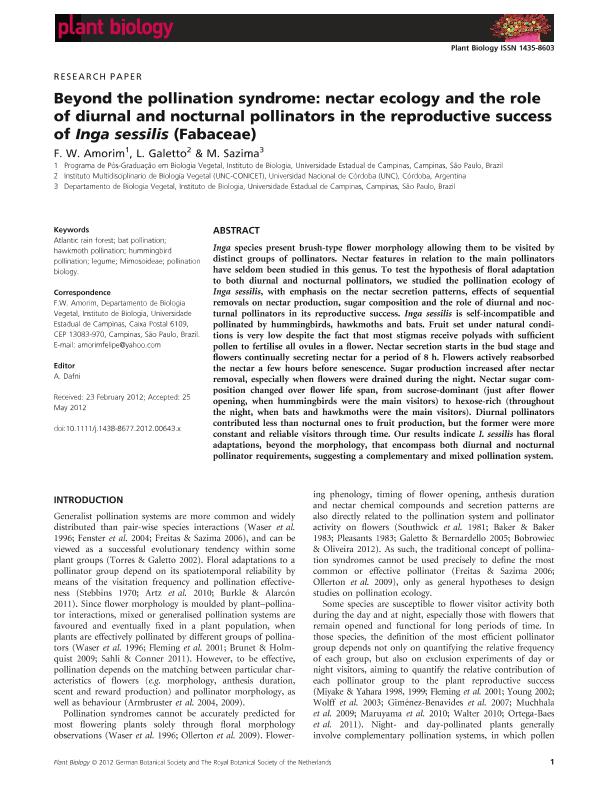Artículo
Behind the pollination syndrome: Nectar ecology and the role of diurnal and nocturnal pollinators in the reproductive success of Inga sessilis (Fabaceae)
Fecha de publicación:
07/2012
Editorial:
Wiley
Revista:
Plant Biology
ISSN:
1435-8603
Idioma:
Inglés
Tipo de recurso:
Artículo publicado
Clasificación temática:
Resumen
Inga species present brush-type flower morphology allowing them to be visited by
distinct groups of pollinators. Nectar features in relation to the main pollinators
have seldom been studied in this genus. To test the hypothesis of floral adaptation
to both diurnal and nocturnal pollinators, we studied the pollination ecology of
Inga sessilis, with emphasis on the nectar secretion patterns, effects of sequential
removals on nectar production, sugar composition and the role of diurnal and nocturnal
pollinators in its reproductive success. Inga sessilis is self-incompatible and
pollinated by hummingbirds, hawkmoths and bats. Fruit set under natural conditions
is very low despite the fact that most stigmas receive polyads with sufficient
pollen to fertilise all ovules in a flower. Nectar secretion starts in the bud stage and
flowers continually secreting nectar for a period of 8 h. Flowers actively reabsorbed
the nectar a few hours before senescence. Sugar production increased after nectar
removal, especially when flowers were drained during the night. Nectar sugar composition
changed over flower life span, from sucrose-dominant (just after flower
opening, when hummingbirds were the main visitors) to hexose-rich (throughout
the night, when bats and hawkmoths were the main visitors). Diurnal pollinators
contributed less than nocturnal ones to fruit production, but the former were more
constant and reliable visitors through time. Our results indicate I. sessilis has floral
adaptations, beyond the morphology, that encompass both diurnal and nocturnal
pollinator requirements, suggesting a complementary and mixed pollination system.
Archivos asociados
Licencia
Identificadores
Colecciones
Articulos(IMBIV)
Articulos de INST.MULTIDISCIPL.DE BIOLOGIA VEGETAL (P)
Articulos de INST.MULTIDISCIPL.DE BIOLOGIA VEGETAL (P)
Citación
Amorim, F. W.; Galetto, Leonardo; Sazima, M.; Behind the pollination syndrome: Nectar ecology and the role of diurnal and nocturnal pollinators in the reproductive success of Inga sessilis (Fabaceae); Wiley; Plant Biology; 15; 2; 7-2012; 317-327
Compartir
Altmétricas
Items relacionados
Mostrando titulos relacionados por título, autor y tema.
-
Moré, Marcela; Ibañez, Ana Clara ; Drewniak, María Eugenia ; Cocucci, Andrea Aristides ; Raguso, Robert A. (Frontiers Media S.A., 2020-12)
-
Delgado-Carrillo, Oliverio; Martén-Rodríguez, Silvana; Ashworth, Lorena ; Aguilar, Ramiro ; Lopezaraiza-Mikel, Martha; Quesada, Mauricio (Wiley-Blackwell, 2018-11)




